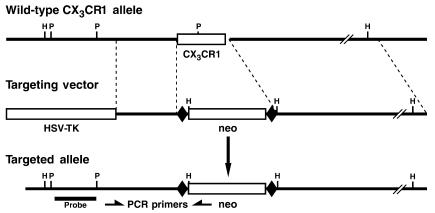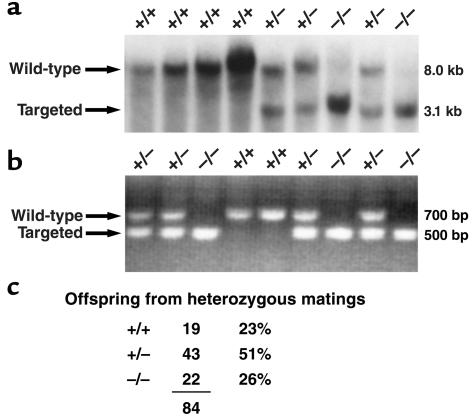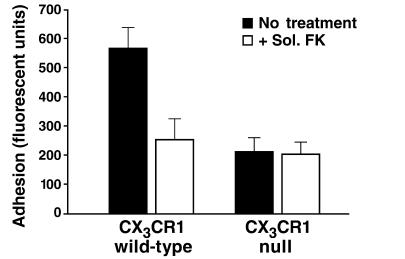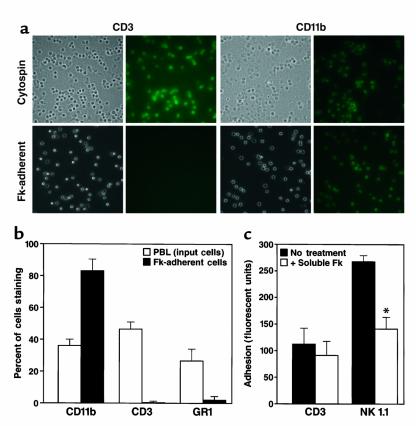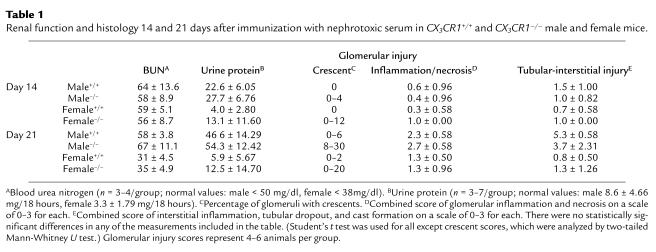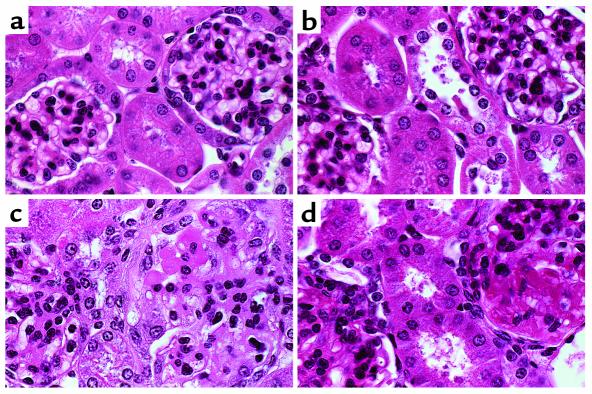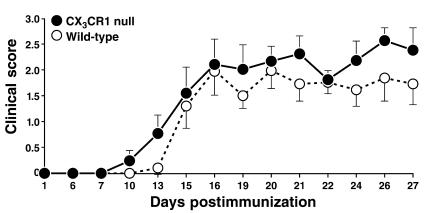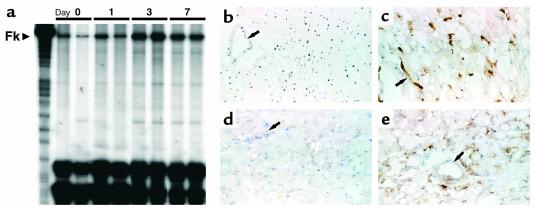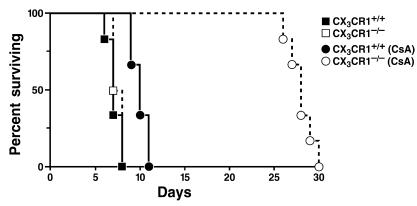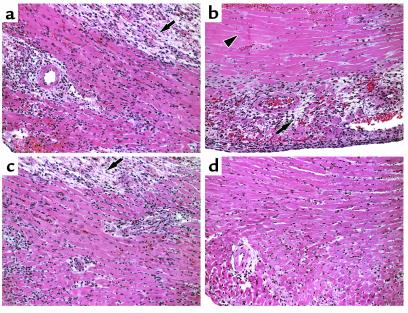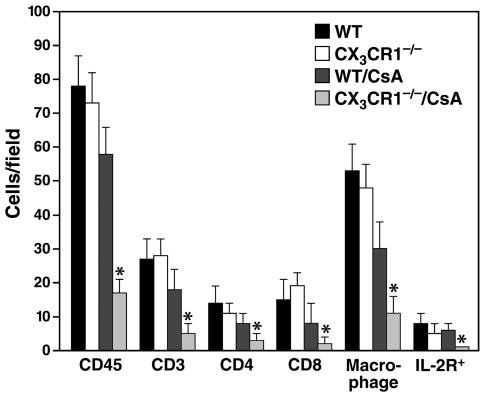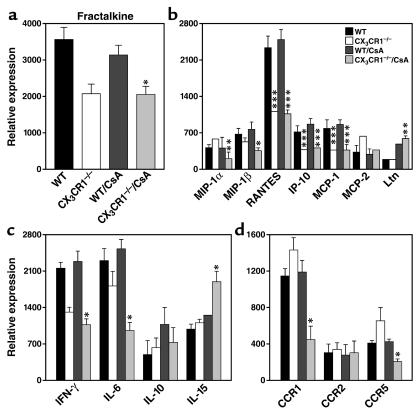Abstract
Fractalkine (Fk) is a structurally unusual member of the chemokine family. To determine its role in vivo, we generated mice with a targeted disruption of CX3CR1, the receptor for Fk. CX3CR1–/– mice were phenotypically indistinguishable from wild-type mice in a pathogen-free environment. In response to antibody-induced glomerulonephritis, CX3CR1–/– and CX3CR1+/+ mice had similar levels of proteinuria and injury. CX3CR1–/– and CX3CR1+/+ mice also developed similar levels of disease in myelin oligodendrocyte glycoprotein-induced experimental autoimmune encephalomyelitis. We performed heterotopic MHC class I/II cardiac transplants from BALB/c mice into C57BL/6 mice. In the absence of cyclosporin A (CsA), there was no difference in graft survival time between CX3CR1–/– and CX3CR1+/+ recipient mice. However, in the presence of subtherapeutic levels of CsA, graft survival time was significantly increased in the CX3CR1–/– mice. Characterization of cells infiltrating the grafts revealed a selective reduction in natural killer cells in the CX3CR1–/– recipients in the absence of CsA and a reduction in macrophages, natural killer cells, and other leukocytes in the presence of CsA. We conclude that Fk plays an important role in graft rejection. The development of CX3CR1 antagonists may allow reductions in the doses of immunosuppressive drugs used in transplantation.
Introduction
Fractalkine (Fk) is an unusual member of the chemokine family of chemotactic cytokines, and has structural and functional properties not found previously within the chemokine family. Structurally, the chemokine-like domain of Fk is fused to a mucin stalk and transmembrane domain, placing it at the cell surface where it can effectively interact with other cells, such as circulating leukocytes. Functionally, Fk can efficiently capture cells through a direct interaction with its cognate receptor, CX3CR1, and thus acts as an effective adhesion molecule (1–4). Another chemokine (CXCL16) with a similar unusual architecture has been reported recently (5).
Fk, which in the mouse is known as neurotactin, is expressed on the surface of activated endothelial cells in the vasculature and on neurons in the CNS, where it appears to be involved in regulating the activity of microglia (1, 6). It is upregulated by proinflammatory cytokines and lipopolysaccharide and is shed as a soluble protein, presumably through a posttranslational cleavage event (1, 4, 7, 8). Soluble Fk is as potent a chemoattractant as other members of the chemokine family (2). Recent data suggest potential roles for Fk in glomerulonephritis, the microglial response to neuronal injury and inflammation of cardiac endothelium (7, 9–11).
To provide more definitive data on the role of Fk in vivo, we used homologous recombination in embryonic stem (ES) cells to create CX3CR1-deficient mice. In a pathogen-free environment, CX3CR1-null mice were viable, fertile, and indistinguishable from wild-type littermates. Examination of peripheral blood cells indicated that CX3CR1 plays a critical and nonredundant role in mononuclear cell adhesion to immobilized Fk. Despite its prominent expression in the CNS, we found no evidence for developmental defects or any differences in disease severity between CX3CR1+/+ and CX3CRI–/– mice in myelin oligodendrocyte glycoprotein–induced (MOG-induced) experimental autoimmune encephalomyelitis (EAE). Similarly, we found no difference in acute nephritis induced by anti-glomerular basement membrane antiserum. In a murine model of cardiac transplantation, however, immunosuppressed CX3CR1–/– recipients had a dramatic prolongation in graft survival time. These studies provide strong evidence for a role for Fk in immune-mediated vascular disease.
Methods
Generation of CX3CR1–/– mice.
A bacterial artificial chromosome (BAC) library from Research Genetics (Huntsville, Alabama, USA) was screened for the murine CX3CR1 gene by PCR. The primers used were: GTCCTCGCCCTCACCAACAGC and TTGAGAGTCTCCAGGAAAATCA. A BAC containing CX3CR1 was identified (plate 52, K17). Restriction mapping of the CX3CR1-containing region was followed by subcloning of SacI and XbaI fragments containing the CX3CR1 gene and flanking sequences. These fragments were subcloned into a shuttle vector and the ends were sequenced. From this sequence information, primers were designed to amplify the 2.3-kb short arm and the 5.9-kb long arm from the SacI and XbaI fragments, respectively. The Long PCR kit was used (Roche Molecular Biochemicals, Indianapolis, Indiana, USA), and the primers were designed with restriction nuclease sites added onto the ends. The primers were: short arm GCATCGATTGTCCACACTTTGGTCTTCC, GCGTCGACGGTGAGGTCCTGGAGGGGAAGG, and long arm ATGGCGCGCCCATCAGATTTCCCTGCCGCT, ATGGCCGGCCGCTCCAGTGACAGGAAACTG. Using primer-encoded restriction sites, the short and long arms were cloned into the pSV-Neo-TK vector (12) using ClaI and SalI or AscI and FseI. The CX3CR1 targeting vector was linearized and electroporated into RF8 ES cells, and cultured on leukemia-inhibiting factor–producing STO feeder cells, as previously described (13). Clones resistant to both G418 (150 μg/ml) and FIAU (0.25 mM) were screened by Southern analysis of HindIII-digested genomic DNA hybridized with a probe located 5′ of the targeting vector (Figure 1). This Southern assay was also used for screening the mouse lines. In addition, a PCR assay was used to screen mouse lines containing a common 5′ primer, AAGATAGGATGAGTGAAGAC, and two 3′ primers, TAC CGGTGGATGTGGAATGTGTGCG (neo gene) and GGTTGTTCATGGAGTTGGCGG (CX3CR1 coding region). Unless otherwise indicated, all mice used in these studies were 50:50 hybrids of the C57BL/6 and 129/Sv strains.
Figure 1.
Targeting vector for the CX3CR1 gene. The top line shows a partial restriction map of the CX3CR1 locus indicating the recognition sites for HindIII (H) and PstI (P). The targeting vector is shown in the center, and the predicted structure of the targeted allele after homologous recombination is shown below. The coding region for CX3CR1 is indicated by the thick bar. The neo gene is flanked by loxP sites for removal. Also indicated are the locations of the PCR primers and the probe used for screening the ES cells and the mice.
Adhesion of peripheral blood leukocytes to Fk and Ab staining.
Peripheral blood leukocytes were isolated as described (14). In brief, blood was taken from the inferior vena cava of a lightly anesthetized mouse and centrifuged at 100 g for 30 minutes. Red cells were removed by hypotonic lysis (155 mM NH4Cl, 10 mM KHCO3, 100 μM EDTA) for 15 minutes, and the cells were washed with assay buffer. In some experiments, natural killer (NK) cells and T cells were purified before the adhesion assay. Cell suspensions from spleens and lymph nodes (inguinal and axillary) were pooled and passed through 70-μm strainers (Falcon; Becton Dickinson Labware, Franklin Lakes, New Jersey, USA), and washed with HBBS supplemented with 1% FCS (vol/vol) and 1% HEPES (10 mM). Red cells were lysed by hypotonic lysis, washed with staining buffer (PBS plus 1% FCS and 0.1% NaN3), and resuspended at a concentration of 106 cells/ml. Cells were stained with Ab’s NK1.1 (phycoerythrin, 0.25 μg/ml) and CD3 (cychrome, 0.25 μg/ml) (PharMingen, San Diego, California, USA) for 30 minutes at 4°C, washed twice with staining buffer, and resuspended at a final concentration of 15 × 106 cells/ml for sorting in a FacsVantage cell sorter (Becton Dickinson, Mountain View, California, USA).
Static adhesion assays were performed as described previously (15). Cells were adhered to a glass slide with a Cytospin centrifuge (Shandon Lipshaw, Pittsburgh, Pennsylvania, USA), at 17.9 g for 3 minutes. Both Fk-adherent and cytospun cells were labeled with biotin-conjugated primary Ab’s: hamster anti-CD3, rat anti-CD11b, and rat anti–Ly-6G (1:200 dilution in 100 μl of labeling buffer, PBS with 1% BSA and 0.1% sodium azide, 30 minutes on ice) (PharMingen). Slides were washed twice with labeling buffer and incubated with streptavidin-FITC (20 minutes on ice). The slides were washed and incubated in 3% paraformaldehyde (for 5 minutes) and viewed with a TE-300 inverted microscope (Nikon, Tokyo, Japan) with a Diagnostics SPOT RT digital camera (Diagnostic Instruments, Sterling Heights, Michigan, USA). Diagnostic SPOT proprietary imaging software plus Twain for Windows 95/98/NT. Images were prepared with PhotoShop 5.5 (Adobe Systems Inc., Santa Clara, California, USA) and IPTK 3.0 Image Analysis Toolkit (Reindeer Games, Ashville, North Carolina, USA).
Induction of nephritis.
Sheep were immunized with a lysate of glomeruli prepared from Sprague-Dawley rat kidneys, as described (16). Nephrotoxic serum (NTS) was heat inactivated at 56°C for 45 minutes, absorbed overnight with mouse red blood cells, and sterilized by passage through a 0.2-μm filter before use. The mice were backcrossed three times into the CD1 genetic background. Male and female CX3CR1+/+ and CX3CR1–/– mice (males ∼35 g and females ∼23 g) were sensitized by subcutaneous injection of 200 μg of normal sheep IgG in CFA in divided doses in each flank. Beginning 5 days later, the mice received daily injections of NTS (males: 50 μl, females: 30 μl) for 3 days; control mice received equivalent doses of normal sheep serum. At intervals of 3 to 21 days after the first dose of NTS, groups of mice (3–4/group) were sacrificed, the kidneys were harvested, and blood was collected by cardiac puncture.
Renal immunopathology.
Kidney halves were fixed overnight at 4°C in 10% neutral buffered formalin, embedded in paraffin, sectioned at 4 μm, and stained with periodic acid–Schiff reagent and Masson’s trichrome for routine histology. All morphological evaluations were performed in a blinded fashion with three or four kidneys from each group at each time point as described (17). Glomerular pathology was assessed by evaluating at least 100 glomeruli per kidney for hypercellularity, necrosis, hyalinosis, microaneurysms, and crescent formation. Interstitial injury was assessed by determining the proportion of cortical tubules with atrophy, necrosis, dilatation, or casts, and the proportion of cortical-interstitium–containing inflammatory infiltrates. Snap-frozen kidney halves were also sectioned and examined with mAb’s for mouse leukocyte surface markers as described (17).
Renal function.
Urinary protein excretion was measured at intervals from 0 to 21 days on overnight urine collections from mice housed in individual metabolic cages. During the urine collection, mice were allowed free access to water but not food. Protein concentration was assayed with the Microprotein PR reagent kit (Sigma Chemical Co., St. Louis, Missouri, USA). Blood urea nitrogen was measured on serum samples taken at intervals from 0 to 21 days using the Urea Nitrogen assay kit (Sigma Chemical Co.).
Experimental autoimmune encephalomyelitis.
CX3CR1+/+ and CX3CR1–/– mice (n = 10/group) were immunized subcutaneously with 100 μg of MOG peptide (MEVGWYRSPFSRVVHLYRNGK) in CFA (Sigma Chemical Co.) supplemented with Mycobacterium tuberculosis antigen (4 mg/ml) (Difco Laboratories, Detroit, Michigan, USA); mice also received 150 ng of pertussis toxin (Sigma Chemical Co.) by intravenous injection at day 0 and day 2, as described (18). Mice were weighed and scored daily in a blinded manner as described (18). Scores were as follows: 0, normal; 1, loss of tail tone; 2, posterior paresis; 3, posterior paralysis and loss of righting response; and 4, tetraparesis/moribund. Comparisons of disease incidence and severity were performed using the Fisher exact test and the two-tailed t test, respectively.
Transplantation.
Heterotopic cardiac allografts were performed as described (19), using BALB/c (H-2d) donors and fully MHC-mismatched CX3CR1–/– or CX3CR1+/+ B6/129 (H-2b) recipients (n = 6/group); control B6/129 mice included littermates and CX3CR1+/+ mice obtained from The Jackson Laboratories (Bar Harbor, Maine, USA). Cyclosporin A (CsA) (Sigma Chemical Co.) was dissolved in olive oil and was administered daily (10 mg/kg, intraperitoneal injection) for 14 days, beginning on the day of engraftment.
Cardiac immunopathology.
Histologic evaluation was performed on paraffin sections stained with hematoxylin and eosin (H&E). Infiltrating cells were detected by immunoperoxidase staining of cryostat sections with rat anti-mouse mAbs (PharMingen), and rabbit anti-rat Fk and CX3CR1 polyclonal Ab’s (Torrey Pines Biolabs, Houston, Texas, USA), as described (20). Immunoperoxidase-stained sections of allografts harvested at serial intervals after transplant (days 1, 3, and 7), plus pretransplant samples (day 0), were evaluated by quantitative morphometry using 20 fields per graft and 3 grafts per group (21).
Ribonuclease protection assays.
Intragraft expression of cytokine, chemokine, and chemokine receptor mRNA was determined by ribonuclease protection assay (RPA) at day 7 after transplant (n = 3/group), using RiboQuant kits from PharMingen. Expression levels were normalized to GAPDH or L32 gene expression (21, 22). RPA analysis was performed twice using separate sets of grafts each time. For Fk, a mouse expressed sequence tag clone (GenBank accession no. AA273590) was confirmed by sequencing and subcloned to prepare an RPA template, which resulted in a 256-bp protected fragment after nuclease digestion.
Results
Generation of CX3CR1–/– mice.
To selectively delete CX3CR1, we generated a targeting vector in which the entire coding region was replaced by a neomycin-resistance gene (Figure 1). ES cell clones were screened for correct homologous recombination and injected into blastocysts to generate chimeric male mice. Matings between heterozygous offspring from these mice resulted in mice homozygous for the CX3CR1 deletion (Figure 2). CX3CR1–/– mice were born at the expected Mendelian ratios: 19 CX3CR1+/+ (23%); 43 CX3CR1+/– (51%); and 22 CX3CR1–/– (26%). They showed no overt developmental or morphological abnormalities and were fertile.
Figure 2.
Targeted deletion of the CX3CR1 gene. Genomic DNA from F2 offspring of heterozygous (+/–) parents was screened by both Southern blot analysis and PCR. (a) Southern blot. Restriction endonuclease digestion with HindIII was probed with a fragment from the 5′ untranslated region and produced a wild-type fragment of 8 kb and a targeted fragment of 3.1 kb. The wild-type and targeted fragments are indicated with the genotype of each mouse shown above the lane. (b) PCR. A set of three primers was used: one 5′ primer that annealed in the 5′ untranslated region and two 3′ primers, one each from the neo and CX3CR1 genes. The reaction resulted in band sizes of 700 bp for the wild-type allele and 500 bp for the targeted allele.
Peripheral blood leukocyte adhesion to Fk.
CX3CR1 is the only nonviral receptor known to interact with Fk (2, 23). To determine whether deletion of CX3CR1 eliminated all activity toward Fk, we measured adhesion of murine peripheral blood leukocytes to tethered Fk in a static adhesion assay. Leukocytes from the CX3CR1+/+ mice adhered well to Fk, and addition of soluble Fk reduced this interaction to near background levels (Figure 3). In contrast, we were unable to detect specific binding of cells from CX3CR1–/– to Fk, suggesting that they lacked functional Fk receptors.
Figure 3.
Peripheral blood cell adhesion to Fk. Peripheral blood was obtained from CX3CR1 wild-type and null mice, and the leukocytes were isolated as a buffy coat. Cells were labeled with the fluorescent dye 2′,7′-bis-(2-carboxyethyl)-5-(and-6)-carboxyfluorescein, acetoxymethyl ester, and tested for adhesion to Fk in cell culture chambers. Excess cells were washed off after a 30-minute incubation, and adhesion was measured as a function of fluorescence. Results are reported as arbitrary fluorescent units. Excess soluble Fk (100 nM) was added to compete with adhesion to the tethered Fk. This assay is representative of three performed. The adhesion of wild-type cells was significantly reduced by the addition of soluble Fk (P < 0.001).
CX3CR1 expression has been demonstrated on circulating monocytes and T cells in humans and rats, and on NK cells in humans and mice (2, 10, 23, 24). We used the Fk adhesion assay to identify cell types in murine peripheral blood that interacted with Fk. As shown in Figure 4a, although CD3+ T cells comprised a large percentage of the input cells, virtually none adhered to Fk in the static assay. Most of the cells that bound to Fk stained positive for CD11b, a marker for monocytes and neutrophils. The neutrophil-specific GR1 mAb did not stain the adherent cell population, indicating that these cells were predominately monocytes. In addition, purified murine neutrophils failed to adhere to Fk (data not shown). These data are quantified in Figure 4b. Because NK cells comprise a small fraction of the total peripheral blood leukocytes, they were purified and analyzed separately. As shown in Figure 4c, purified NK cells, but not CD3 T cells, demonstrated specific binding to immobilized Fk. These results indicate that murine monocytes and NK cells, but not T cells, express functional Fk receptors and that CX3CR1 plays a nonredundant role in cellular adhesion to Fk.
Figure 4.
Cell types adhering to Fk. (a) Peripheral blood leukocytes from CX3CR1+/+ mice were isolated as a buffy coat and either spun onto a glass slide (cytospin) or allowed to adhere to Ab- tethered Fk (Fk-adherent). Cells were then labeled with biotinylated Ab’s (CD3 or CD11b) and fluorescent streptavidin for identification. Bright-field and fluorescent images were captured. (b) Quantitation of cell types binding to Fk. Three fields were counted for each labeling condition, and the percentage of each cell type in the input population and Fk-adherent population is shown. The experiment shown is representative of two. (c) Adhesion of purified NK and T cells to Fk. NK (NK1.1+, CD3–) and T (CD3+, NK1.1–) cells were purified and fluorescently labeled. Cells were allowed to adhere to Ab-tethered Fk, in the presence or absence of soluble (100 nM) Fk. The experiment shown is representative of three. The asterisk indicates P < 0.005.
CX3CR1 –/– and CX3CR1+/+ mice develop equally severe glomerular and interstitial injury.
Fk is expressed on glomerular endothelium, and CX3CR1-bearing leukocytes infiltrate the glomeruli in the Wistar-Kyoto rat model of crescentic glomerulonephritis (10). In that model, administration of a polyclonal Ab directed against rat CX3CR1 or treatment with the viral protein vMIP-II inhibited leukocyte infiltration and crescent formation and improved renal function (10, 25). We sought to determine if the interaction of Fk and CX3CR1 contributes to glomerular and interstitial injury in an accelerated model of nephrotoxic nephritis in mice. As measured by elevation of blood urea nitrogen, proteinuria, and quantitative morphology, renal injury was equally severe in wild-type and CX3CR1–/– mice (Table 1). Although there was less injury in females than in males and the severity varied between animals in each group, all animals exhibited some degree of glomerular and interstitial inflammation when examined 14 and 21 days after immunization (Table 1, Figure 5). Blood urea nitrogen was equally elevated from day 3 in both groups of male and female mice and was persistently elevated in the males on day 21 (Table 1). Proteinuria was also present in both groups of male and female mice from day 3 and was undiminished by CX3CR1 deficiency. In fact, there was a nonsignificant trend toward higher levels of urine protein excretion in female CX3CR1–/– than in female CX3CR1+/+ mice after 14 and 21 days (Table 1). Quantitative immunohistochemistry for all leukocytes, granulocytes, macrophages, and T-cell subsets revealed no differences between CX3CR1+/+ and CX3CR1–/– nephritic mice (data not shown).
Table 1.
Renal function and histology 14 and 21 days after immunization with nephrotoxic serum in CX3CR1+/+ and CX3CR1–/– male and female mice.
Figure 5.
Histology of control and nephritic kidneys. CX3CR1+/+ (a, c) and CX3CR1–/– (b, d) mice were preimmunized with normal sheep serum and then injected intravenously with normal sheep serum or nephrotoxic serum. Sections of kidneys harvested from mice immunized with normal sheep serum show normal renal morphology (a, b). In contrast, cortical sections obtained 21 days after injection with nephrotoxic serum (c, d) show proliferative and inflammatory glomerular changes, including hypercellularity, focal necrosis, increased matrix, thickening of capillary loops, and occlusion by matrix and microthrombi, as well as a periglomerular interstitial mononuclear cell infiltrate. (H&E-stained paraffin sections; original magnification, ×790). Shown are representative sections from 4 to 6 animals per group.
EAE.
Given reports of the upregulation of Fk during EAE (9, 26) and expression of CX3CR1 by microglial cells (6, 27), we tested the importance of CX3CR1 in the pathogenesis of EAE by comparing disease severity in CX3CR1+/+ and CX3CR1–/– mice. As seen in Figure 6, there was no significant difference between the groups with respect to clinical scores or in disease incidence (data not shown).
Figure 6.
Lack of requirement for CX3CR1 expression in development of murine EAE. Wild-type and CX3CR1-null mice were immunized with MOG peptide and weighed and scored daily. No significant differences were noted at any point. Results are representative of two separate experiments, using 10 mice per group in each experiment.
Cardiac allograft survival.
Given the prominent expression of Fk on endothelial cells and a report of Fk upregulation by inflamed heart tissue (7), we sought to determine if Fk plays a role in cardiac allograft rejection. BALB/c (H-2d) donor hearts were implanted into fully MHC-mismatched B6/129 (H-2b) mice. At the RNA level, Fk expression was induced in the grafted heart as early as 1 day after transplant and was maximally upregulated by day 3 (Figure 7a). At the protein level, both Fk and CX3CR1 were detected in the capillary beds of rejecting hearts (Figure 7, d and e), but not control hearts (Figure 7b). To determine if Fk was playing a role in the rejection process, we compared the survival of CX3CR1–/– and CX3CR1+/+ recipient mice after cardiac transplantation. In the absence of immunosuppression, there was no difference in graft survival between the two genotypes (Figure 8). In the presence of CsA, however, there was a dramatic prolongation of graft survival in the CX3CR1–/– mice (Figure 8). Histological examination of the hearts revealed prominent cellular infiltrates in the CX3CR1+/+ recipients (with or without CsA) and the CX3CR1–/– recipients in the absence of CsA, but not in the CX3CR1–/– mice treated with CsA (Figure 9). Given our data on the expression of CX3CR1 by mouse NK cells and monocytes, we undertook a serial analysis of infiltration by these cell types after cardiac transplantation (Figure 10). The early recruitment of NK cells seen at day 3 after transplant was decreased in CX3CR1–/– vs. CX3CR1+/+ allograft recipients (P < 0.001), and use of CsA further diminished the numbers of NK cells in CX3CR1–/– recipients (P < 0.05 for CX3CR1–/– receiving CsA vs. CX3CR1–/– alone). Use of CsA decreased day 3 macrophage recruitment (P < 0.001) in both CX3CR1+/+ and CX3CR1–/– recipients, but again the lowest numbers of cells were seen in CX3CR1–/– recipients treated with CsA (P < 0.01 vs. CX3CR1+/+ mice on CsA) (Figure 10).
Figure 7.
Expression of Fk and CX3CR1 during development of cardiac allograft rejection. (a) RPA analysis of Fk mRNA expression showing baseline expression in two control hearts (day 0) and increasing expression in allografts harvested at day 1, 3, or 7 after transplant. Arrow indicates Fk-protected fragment. Each lane represents mRNA from a different allograft. (b) Immunoperoxidase staining of normal heart with an anti-Fk Ab. Heart harvested 7 days after transplant and stained with an anti-Fk Ab (c) or with control IgG (d). (e) Infiltrating mononuclear cells in day-7 allografts stained for CX3CR1. Arrows in b–e indicate examples of intragraft vascular endothelium; cryostat sections with hematoxylin counterstain. Original magnifications, ×200.
Figure 8.
Survival of CX3CR1–/– and CX3CR1+/+ recipient mice after cardiac transplantation. CX3CR1–/– mice rejected fully MHC-disparate cardiac allografts at the same tempo as CX3CR1+/+ recipients. However, whereas administration of a subtherapeutic dose of CsA prolonged allograft survival only 2–3 days in CX3CR1+/+ recipients, allograft survival was significantly prolonged in CX3CR1–/– mice treated with the same course of CsA (P < 0.005 Mann-Whitney vs. wild-type/CsA, n = 6/group).
Figure 9.
Comparison of histology of cardiac allografts. (a) CX3CR1+/+ recipients, (c) CX3CR1+/+ recipients treated with CsA, and (b) CX3CR1–/– recipients each show severe cellular rejection with extensive mononuclear cell infiltration and myocyte necrosis (arrows). CX3CR1–/– recipients (b) also showed areas of coagulative necrosis (arrowhead). By contrast, CX3CR1–/– recipients (d) treated with CsA showed intact myocardium and vessels and only a mild degree of mononuclear cell infiltration. (H&E-stained paraffin sections, representative of n = 6/group).
Figure 10.
Serial analysis of NK cell and macrophage infiltration of cardiac allografts. Allografts (3/group) were harvested on day 0 (pretransplant) and 1, 3, and 7 days after transplant, and the extent (mean ± SD, 20 fields/graft) of NK cell (DX3+) and macrophage (F4/80+) infiltration was determined. (a) The number of intragraft NK cells peaked at day 3 and was significantly decreased on days 1 and 3 in the CX3CR1–/– recipients. Administration of CsA decreased NK cell infiltration in both CX3CR1+/+ and CX3CR1–/– mice (*P < 0.001, ** P < 0.005). On day 3 after transplant in the presence of CsA there were fewer NK cells in the CX3CR1–/– recipients than in the CX3CR1+/+ mice (P < 0.05). (b) Macrophage recruitment at days 3 and day 7 after transplant was diminished by CsA (*P < 0.001 comparing no CsA versus plus CsA). Macrophage recruitment was most depressed in CX3CR1–/– recipients in the presence of CsA (P < 0.01 comparing CX3CR1+/+ versus CX3CR1–/– recipients at day 3 after transplant; P < 0.001 comparing these same groups at day 7).
Comparison of intragraft populations at day 7, just before rejection in all but the CX3CR1–/– mice treated with CsA, showed broadly similar numbers of each cell type in CX3CR1+/+ vs. CX3CR1–/– recipients, whereas use of CsA in wild-type mice led to a modest decrease in overall cellularity (CD45+), as well as T cells and T cell subsets and macrophages (Figure 11). However, allografts in CX3CR1–/– mice receiving CsA showed a further marked decrease (P < 0.01) in each of these leukocyte populations, as well as evidence of immune activation (IL-2R expression), when compared with each of the other groups.
Figure 11.
Leukocyte accumulation at day 7 after transplant. Analysis of immunoperoxidase-stained cell populations showed significant reductions (*P < 0.01) in recruitment of intragraft CD45+ cells (all leukocytes); T cells (CD3); CD4 and CD8 T cell subsets; macrophages and IL-2R+ (CD25+) cells in CX3CR1–/– animals treated with CsA vs. each of the other three groups. (Mean ± SD, 20 consecutive fields per graft and three grafts per group.)
To elucidate the mechanisms underlying the increased survival of CsA-treated CX3CR1–/– mice, we measured chemokine and cytokine levels in the grafted hearts. Fk and RANTES (Figure 12) were the most abundant of the chemokines assayed and were present at lower levels in CX3CR1–/– mice than in wild-type mice. Treatment with CsA did not affect the levels of Fk or RANTES. MCP-1 and IP-10 were also present at reduced levels in the CX3CR1–/– mice. Of the chemokines and cytokines that were measured, IL-6 and macrophage inflammatory proteins-1α and –1β were selectively decreased in CX3CR1–/– mice treated with CsA, as were the receptors CCR1 and CCR5.
Figure 12.
Chemokine and cytokine expression in rejecting allografts. Analysis of day 7 cardiac allografts by RNase protection. (a) Use of CsA did not affect intragraft expression of Fk mRNA, though overall levels in CX3CR1–/– were decreased (P < 0.01) compared with CX3CR1+/+ recipients. (b) Compared with CX3CR1+/+ recipients, targeting of CX3CR1 plus CsA resulted in significant decreases in the chemokines MIP-1α, MIP-1β, RANTES, IP-10, and MCP-1. Ltn, lymphotoxin (c) Decreased levels of IFN-γ and IL-6 in CX3CR1–/– mice treated with CsA. (d) Reduced expression of CCR1 and CCR5 in CX3CR1–/– mice treated with CsA. (Mean ± SD, n = 3/group, Mann-Whitney U test, *P < 0.05, **P < 0.01, and ***P < 0.005.)
Discussion
The interaction of Fk and CX3CR1 can modulate leukocyte function through a number of potential mechanisms, including chemotaxis (1, 2), upregulation of integrins (28), and direct adhesion (1, 3, 4), depending on whether Fk is in the soluble or membrane-tethered form. High levels of expression of Fk and CX3CR1 have been reported in the CNS (6, 9, 29), and evidence for a functional role in glomerulonephritis has also been reported (10, 25). In addition, there is emerging evidence that selected chemokines and their receptors are present and play an important role in transplant rejection (30). To evaluate the importance of the Fk/CX3CR1 interaction in vivo, we used homologous recombination in ES cells to create mice in which the gene for CX3CR1 was selectively deleted. Here we report that Fk/CX3CR1 interactions appear to play a role in the immune-mediated rejection of cardiac allografts, but are not critical for normal CNS development and do not modulate the severity of disease in widely used models of multiple sclerosis or Ab-induced nephritis.
Adhesion of CX3CR1-expressing cells to Fk is rapid and efficient (3) and may provide a mechanism for leukocyte capture in areas of high blood flow, such as renal glomeruli. Many chemokines and chemokine receptors are upregulated in glomerulonephritis, including monocyte chemoattractant protein 1 (MCP-1) (17, 31) and Fk (10). In one study, neutralizing Ab’s to MCP-1 reduced the severity of anti-GBM–mediated disease in mice (32) and similar studies in MCP-1–deficient mice revealed less severe tubular injury than in wild-type nephritic mice (33). Recently, increased severity of nephritis was reported in CCR2-deficient mice in this model (34). Lack of CCR1 has also been shown to enhance the severity of glomerular injury during NTS-induced nephritis, consistent with a role of recruited cells in mediating the resolution of glomerular lesions (17). In rats, Fk expression is upregulated in the glomeruli during anti-glomerular basement membrane–induced nephritis (25); treatment with an anti-CX3CR1 polyclonal Ab decreased leukocyte infiltration in the glomeruli, decreased crescent formation, and improved renal function (10). Similar results were obtained with vMIP-II, a viral protein encoded by herpesvirus 8 that blocks many chemokine/receptor interactions (10). Here we show that when challenged with nephrotoxic serum, no significant differences in renal function or crescent formation were detected between the CX3CR1 wild-type or knockout mice. The lack of concordance between these results and those in the rat may indicate differences in CX3CR1 expression between the two species, features unique to the Wistar-Kyoto rat strain, or a lack of absolute specificity of the antagonists used in the rat studies.
It is worth noting that while the activity and expression of Fk and CX3CR1 in humans and rats have been studied in some detail, much less is known about these proteins in the mouse, and it has been unclear whether or not murine lymphocytes express CX3CR1. In preliminary studies, we were unable to detect chemotaxis or changes in intracellular calcium levels in murine lymphocytes in response to soluble Fk (Haskell and Charo, data not shown). In cell adhesion studies, we found that primary murine monocytes and NK cells, but not lymphocytes or granulocytes, bound to immobilized Fk. These data are consistent with those of Jung et al. (23), who reported expression of CX3CR1 on murine monocytes and NK cells, but not T cells. This unusual discordance between gene expression in humans and mice is interesting and has important implications for the choice of disease models in which to explore Fk function. In addition, the lack of expression of CX3CR1 in murine lymphocytes suggests that expression patterns in the rat should be reinvestigated, as well.
In the CNS, Fk is expressed on neurons, and CX3CR1 is expressed on microglial cells (6, 27), suggesting that neuronally derived Fk may mediate interactions between these two cell types (6). Consistent with this hypothesis, Boehme et al. (35) showed that ligation of CX3CR1 by Fk inhibited Fas-mediated death of rat brain microglia, and others have also reported that Fk has anti-apoptotic activity (36, 37). Neuronal Fk has also been implicated in the pathogenesis of HIV-1 encephalitis (38). Expression of Fk and CX3CR1 in the CNS has raised the question of whether Fk plays a role in multiple sclerosis, a demyelinating disease characterized by a prominent leukocyte infiltrate. Several studies have reported the presence of Fk and or CX3CR1 in EAE, a rodent model of human multiple sclerosis (9, 26, 29, 39). These reports documented Fk expression during the progression of the disease, but did not reach a consensus on the potential importance of the Fk/ CX3CR1 interaction on the severity of disease. In the current study we found no difference in the clinical course of MOG-induced EAE in CX3CR1 wild-type versus knockout mice. This finding is consistent with the report of Schwaeble et al. who used MOG to induce EAE in the rat and found no change in the level of expression of Fk (29). Therefore, despite its prominent expression in the CNS, Fk does not appear to have a functional role in EAE.
With regard to the cardiovascular disease, Harrison et al. (7) reported that inflammatory agents, such as lipopolysaccharide and TNF-α, upregulated in vivo expression of Fk in rat aortic endothelial cells and cardiac myocytes. In the context of organ transplantation, a number of chemokines and their receptors have been detected in rejecting hearts (30), but there are only a few mechanistic studies that speak to their importance in the rejection process. Mulligan et al. (40) showed that a RANTES-neutralizing Ab prolonged heterotopic cardiac graft survival in rats. Using mice that were genetically deficient in CCR1, Gao et al. (21) reported significantly prolonged survival of completely MHC-mismatched cardiac grafts and essentially permanent engraftment of MHC class II mismatched hearts. Horuk et al. showed that a functional antagonist of CCR1 was efficacious in a rat heart transplant model (41). Hancock et al. have also found that, in the presence of CsA, CXCR3 mice maintained their cardiac allografts permanently and without evidence of chronic rejection (22).
Recently, Robinson et al. reported that blockade of CX3CR1, with the same rabbit anti-rat polyclonal Ab as that used in the rat glomerulonephritis studies (10), markedly prolonged survival of completely MHC-mismatched hearts in the mouse in the absence of CsA (42). Here we report that Fk is upregulated in a murine cardiac allograft transplant model, and that CX3CR1-expressing cells infiltrate the transplanted tissue. In the absence of immunosuppressive agents, there was no difference in the time to rejection or in the histological changes between the hearts in the CX3CR1–/– and CX3CR1+/+ mice. We obtained similar results using Fk knockout mice as donors and either wild-type or CX3CR1–/– mice as recipients (Hancock et al., unpublished results). However, in the presence of low levels of CsA, there was a marked prolongation of graft survival in the CX3CR1–/– mice. The reasons for the differences between our data and those of Robinson et al. (42) may relate to the methodology employed. Use of blocking Ab’s may remove all cells that bear the target receptor from the transplant, whereas selective removal of CX3CR1 abrogates only Fk-dependent adhesion and signaling. This is consistent with our finding that CX3CR1–/– and CX3CR1+/+ mice were indistinguishable in acute nephritis model, while protection has been reported using CX3CR1-blocking Ab’s in a similar model, as noted above (10). It will be interesting to determine whether the effect of Fk in transplant rejection is as the tethered, full-length form acting as an adhesion molecule or the soluble form acting as a chemoattractant and integrin-activating agent. This question will likely require the creation of mice with Fk mutated to prevent cleavage.
Because monocytes and NK cells express CX3CR1, and because they have been implicated in the rejection of transplanted organs, the time course of their infiltration into grafted hearts was of particular interest to us. NK cells are effector cells of the innate immune system, and the selective reduction in the number of NK cells in the CX3CR1–/– recipients suggested a functional role in graft rejection. The decreased levels of IFN-γ, MCP-1, and RANTES in the CX3CR1–/– mice could be due to the reduced numbers of NK cells infiltrating the graft. However, despite the reduction in NK cell recruitment, allograft survival was not prolonged in the CX3CR1–/– mice unless they were treated with low-dose CsA. This finding suggests that the NK cells act in concert with CsA-sensitive T cells to effect graft rejection and agrees nicely with the work of Maier et al. (43), who found that CD28–/– mice rejected cardiac allografts vigorously and that depletion of NK cells by injection of the Ab NK1.1 dramatically prolonged graft survival. These authors also reported that treatment of the CD28–/– mice with CsA failed to prolong allograft survival and concluded that CsA did not abrogate NK cell function (43). Taken together with our results, these observations suggest that NK cells of the innate immune system and T cells of the adaptive immune system act in concert to reject transplanted organs and that the Fk/CX3CR1 interaction is critical for recruitment of NK cells to the graft.
In summary, we have shown that CX3CR1 appears to be the primary receptor for Fk in the mouse. Despite high levels of expression of this ligand-receptor pair in the CNS and the kidney, CX3CR1-null mice develop normally and do not have increased susceptibility in widely used models of EAE or acute nephritis. The absence of CX3CR1 confers protection from transplant rejection and a reduction in the number of NK cells in the grafts. These data indicate an early and important role for FK in mediating cell infiltration in transplant rejection. It will be interesting to determine if antagonists of Fk or CX3CR1 will allow the use of reduced levels of immunosuppressive agents in organ transplantation.
Acknowledgments
This work was funded in part by grants from the NIH (HL-63894 and HL-52773 to I.F. Charo) and (AI-40152 to W.W. Hancock). We thank John Carroll and Jack Hull for preparation of the figures, Stephen Ordway and Gary Howard for editorial assistance, and Naima Contos for manuscript preparation.
Footnotes
Christopher A. Haskell’s present address is: Berlex Biosciences, Richmond, California, USA.
Received for publication April 9, 2001, and accepted in revised form July 24.
References
- 1.Bazan JF, et al. A new class of membrane-bound chemokine with a CX3C motif. Nature. 1997;385:640–644. doi: 10.1038/385640a0. [DOI] [PubMed] [Google Scholar]
- 2.Imai T, et al. Identification and molecular characterization of fractalkine receptor CX3CR1, which mediates both leukocyte migration and adhesion. Cell. 1997;91:521–530. doi: 10.1016/s0092-8674(00)80438-9. [DOI] [PubMed] [Google Scholar]
- 3.Haskell CA, Cleary MD, Charo IF. Molecular uncoupling of fractalkine-mediated cell adhesion and signal transduction. Rapid flow arrest of CX3CR1-expressing cells is independent of G-protein activation. J Biol Chem. 1999;274:10053–10058. doi: 10.1074/jbc.274.15.10053. [DOI] [PubMed] [Google Scholar]
- 4.Fong AM, et al. Fractalkine and CX3CR1 mediate a novel mechanism of leukocyte capture, firm adhesion, and activation under physiologic flow. J Exp Med. 1998;188:1413–1419. doi: 10.1084/jem.188.8.1413. [DOI] [PMC free article] [PubMed] [Google Scholar]
- 5.Matloubian M, David A, Engel S, Ryan JE, Cyster JG. A transmembrane CXC chemokine is a ligand for HIV-coreceptor Bonzo. Nat Immunol. 2000;1:298–304. doi: 10.1038/79738. [DOI] [PubMed] [Google Scholar]
- 6.Harrison JK, et al. Role for neuronally derived fractalkine in mediating interactions between neurons and CX3CR1-expressing microglia. Proc Natl Acad Sci USA. 1998;95:10896–10901. doi: 10.1073/pnas.95.18.10896. [DOI] [PMC free article] [PubMed] [Google Scholar]
- 7.Harrison JK, et al. Inflammatory agents regulate in vivo expression of fractalkine in endothelial cells of the rat heart. J Leukoc Biol. 1999;66:937–944. doi: 10.1002/jlb.66.6.937. [DOI] [PubMed] [Google Scholar]
- 8.Chapman GA, et al. Fractalkine cleavage from neuronal membranes represents an acute event in the inflammatory response to excitotoxic brain damage. J Neurosci. 2000;20:RC87 (1–5). doi: 10.1523/JNEUROSCI.20-15-j0004.2000. [DOI] [PMC free article] [PubMed] [Google Scholar]
- 9.Pan Y, et al. Neurotactin, a membrane-anchored chemokine upregulated in brain inflammation. Nature. 1997;387:611–617. doi: 10.1038/42491. [DOI] [PubMed] [Google Scholar]
- 10.Feng L, et al. Prevention of crescentic glomerulonephritis by immunoneutralization of the fractalkine receptor CX3CR1. Kidney Int. 1999;56:612–620. doi: 10.1046/j.1523-1755.1999.00604.x. [DOI] [PubMed] [Google Scholar]
- 11.Garcia GE, et al. NF-κB-dependent fractalkine induction in rat aortic endothelial cells stimulated by IL-1β, TNF-α, and LPS. J Leukoc Biol. 2000;67:577–584. doi: 10.1002/jlb.67.4.577. [DOI] [PubMed] [Google Scholar]
- 12.Ishibashi S, et al. Hypercholesterolemia in low density lipoprotein receptor knockout mice and its reversal by adenovirus-mediated gene delivery. J Clin Invest. 1993;92:883–893. doi: 10.1172/JCI116663. [DOI] [PMC free article] [PubMed] [Google Scholar]
- 13.Meiner VL, et al. Disruption of the acyl-CoA:cholesterol acyltransferase gene in mice: evidence suggesting multiple cholesterol esterification enzymes in mammals. Proc Natl Acad Sci USA. 1996;93:14041–14046. doi: 10.1073/pnas.93.24.14041. [DOI] [PMC free article] [PubMed] [Google Scholar]
- 14.Kim C-J, et al. Polymerase chain reaction–based method for quantifying recruitment of monocytes to mouse atherosclerotic lesions in vivo. Enhancement by tumor necrosis factor-α and interleukin-1β. Arterioscler Thromb Vasc Biol. 2000;20:1976–1982. doi: 10.1161/01.atv.20.8.1976. [DOI] [PubMed] [Google Scholar]
- 15.Haskell CA, Cleary MD, Charo IF. Unique role of the chemokine domain of fractalkine in cell capture. Kinetics of receptor dissociation correlate with cell adhesion. J Biol Chem. 2000;275:34183–34189. doi: 10.1074/jbc.M005731200. [DOI] [PubMed] [Google Scholar]
- 16.Salant DJ, Cybulsky AV. Experimental glomerulonephritis. Methods Enzymol. 1988;162:421–461. doi: 10.1016/0076-6879(88)62096-9. [DOI] [PubMed] [Google Scholar]
- 17.Topham PS, et al. Lack of chemokine receptor CCR1 enhances Th1 responses and glomerular injury during nephrotoxic nephritis. J Clin Invest. 1999;104:1549–1557. doi: 10.1172/JCI7707. [DOI] [PMC free article] [PubMed] [Google Scholar]
- 18.Rottman JB, et al. Leukocyte recruitment during onset of experimental allergic encephalomyelitis is CCR1 dependent. Eur J Immunol. 2000;30:2372–2377. doi: 10.1002/1521-4141(2000)30:8<2372::AID-IMMU2372>3.0.CO;2-D. [DOI] [PubMed] [Google Scholar]
- 19.Hancock WW, Buelow R, Sayegh MH, Turka LA. Antibody-induced transplant arteriosclerosis is prevented by graft expression of anti-oxidant and anti-apoptotic genes. Nat Med. 1998;4:1392–1396. doi: 10.1038/3982. [DOI] [PubMed] [Google Scholar]
- 20.Hancock WW, et al. Costimulatory function and expression of CD40 ligand, CD80, and CD86 in vascularized murine cardiac allograft rejection. Proc Natl Acad Sci USA. 1996;93:13967–13972. doi: 10.1073/pnas.93.24.13967. [DOI] [PMC free article] [PubMed] [Google Scholar]
- 21.Gao W, et al. Targeting of the chemokine receptor CCR1 suppresses development of acute and chronic cardiac allograft rejection. J Clin Invest. 2000;105:35–44. doi: 10.1172/JCI8126. [DOI] [PMC free article] [PubMed] [Google Scholar]
- 22.Hancock WW, et al. Requirement of the chemokine receptor CXCR3 for acute allograft rejection. J Exp Med. 2000;192:1515–1519. doi: 10.1084/jem.192.10.1515. [DOI] [PMC free article] [PubMed] [Google Scholar]
- 23.Jung S, et al. Analysis of fractalkine receptor CX3CR1 function by targeted deletion and green fluorescent protein reporter gene insertion. Mol Cell Biol. 2000;20:4106–4114. doi: 10.1128/mcb.20.11.4106-4114.2000. [DOI] [PMC free article] [PubMed] [Google Scholar]
- 24.Foussat A, et al. Fractalkine receptor expression by T lymphocyte subpopulations and in vivo production of fractalkine in human. Eur J Immunol. 2000;30:87–97. doi: 10.1002/1521-4141(200001)30:1<87::AID-IMMU87>3.0.CO;2-7. [DOI] [PubMed] [Google Scholar]
- 25.Chen S, et al. In vivo inhibition of CC and CX3C chemokine–induced leukocyte infiltration and attenuation of glomerulonephritis in Wistar-Kyoto (WKY) rats by vMIP-II. J Exp Med. 1998;188:193–198. doi: 10.1084/jem.188.1.193. [DOI] [PMC free article] [PubMed] [Google Scholar]
- 26.Fischer FR, et al. Modulation of experimental autoimmune encephalomyelitis: effect of altered peptide ligand on chemokine and chemokine receptor expression. J Neuroimmunol. 2000;110:195–208. doi: 10.1016/s0165-5728(00)00351-9. [DOI] [PubMed] [Google Scholar]
- 27.Nishiyori A, et al. Localization of fractalkine and CX3CR1 mRNAs in rat brain: does fractalkine play a role in signaling from neuron to microglia? FEBS Lett. 1998;429:167–172. doi: 10.1016/s0014-5793(98)00583-3. [DOI] [PubMed] [Google Scholar]
- 28.Goda S, et al. CX3C-chemokine, fractalkine-enhanced adhesion of THP-1 cells to endothelial cells through integrin-dependent and -independent mechanisms. J Immunol. 2000;164:4313–4320. doi: 10.4049/jimmunol.164.8.4313. [DOI] [PubMed] [Google Scholar]
- 29.Schwaeble WJ, et al. Neuronal expression of fractalkine in the presence and absence of inflammation. FEBS Lett. 1998;439:203–207. doi: 10.1016/s0014-5793(98)01384-2. [DOI] [PubMed] [Google Scholar]
- 30.Hancock WW, Gao W, Faia KL, Csizmadia V. Chemokines and their receptors in allograft rejection. Curr Opin Immunol. 2000;12:511–516. doi: 10.1016/s0952-7915(00)00130-8. [DOI] [PubMed] [Google Scholar]
- 31.Schadde E, et al. Expression of chemokines and their receptors in nephrotoxic serum nephritis. Nephrol Dial Transplant. 2000;15:1046–1053. doi: 10.1093/ndt/15.7.1046. [DOI] [PubMed] [Google Scholar]
- 32.Lloyd CM, et al. RANTES and monocyte chemoattractant protein–1 (MCP-1) play an important role in the inflammatory phase of crescentic nephritis, but only MCP-1 is involved in crescent formation and interstitial fibrosis. J Exp Med. 1997;185:1371–1380. doi: 10.1084/jem.185.7.1371. [DOI] [PMC free article] [PubMed] [Google Scholar]
- 33.Tesch GH, et al. Monocyte chemoattractant protein-1 promotes macrophage-mediated tubular injury, but not glomerular injury, in nephrotoxic serum nephritis. J Clin Invest. 1999;103:73–80. doi: 10.1172/JCI4876. [DOI] [PMC free article] [PubMed] [Google Scholar]
- 34.Bird JE, et al. Increased severity of glomerulonephritis in C-C chemokine receptor 2 knockout mice. Kidney Int. 2000;57:129–136. doi: 10.1046/j.1523-1755.2000.00848.x. [DOI] [PubMed] [Google Scholar]
- 35.Boehme SA, Lio FM, Maciejewski-Lenoir D, Bacon KB, Conlon PJ. The chemokine fractalkine inhibits Fas-mediated cell death of brain microglia. J Immunol. 2000;165:397–403. doi: 10.4049/jimmunol.165.1.397. [DOI] [PubMed] [Google Scholar]
- 36.Meucci O, Fatatis A, Simen AA, Miller RJ. Expression of CX3CR1 chemokine receptors on neurons and their role in neuronal survival. Proc Natl Acad Sci USA. 2000;97:8075–8080. doi: 10.1073/pnas.090017497. [DOI] [PMC free article] [PubMed] [Google Scholar]
- 37.Zujovic V, Benavides J, Vigé X, Carter C, Taupin V. Fractalkine modulates TNF-α secretion and neurotoxicity induced by microglial activation. Glia. 2000;29:305–315. [PubMed] [Google Scholar]
- 38.Tong N, et al. Neuronal fractalkine expression in HIV-1 encephalitis: roles for macrophage recruitment and neuroprotection in the central nervous system. J Immunol. 2000;164:1333–1339. doi: 10.4049/jimmunol.164.3.1333. [DOI] [PubMed] [Google Scholar]
- 39.Jiang Y, et al. Chemokine receptor expression in cultured glia and rat experimental allergic encephalomyelitis. J Neuroimmunol. 1998;86:1–12. doi: 10.1016/s0165-5728(98)00005-8. [DOI] [PubMed] [Google Scholar]
- 40.Mulligan MS, et al. Role of Rantes in experimental cardiac allograft rejection. Exp Mol Pathol. 2000;69:167–174. doi: 10.1006/exmp.2000.2327. [DOI] [PubMed] [Google Scholar]
- 41.Horuk R, et al. A non-peptide functional antagonist of the CCR1 chemokine receptor is effective in rat heart transplant rejection. J Biol Chem. 2001;276:4199–4204. doi: 10.1074/jbc.M007457200. [DOI] [PubMed] [Google Scholar]
- 42.Robinson LA, et al. A role for fractalkine and its receptor (CX3CR1) in cardiac allograft rejection. J Immunol. 2000;165:6067–6072. doi: 10.4049/jimmunol.165.11.6067. [DOI] [PubMed] [Google Scholar]
- 43.Maier S, et al. Inhibition of natural killer cells results in acceptance of cardiac allografts in CD28–/– mice. Nat Med. 2001;7:557–562. doi: 10.1038/87880. [DOI] [PubMed] [Google Scholar]



